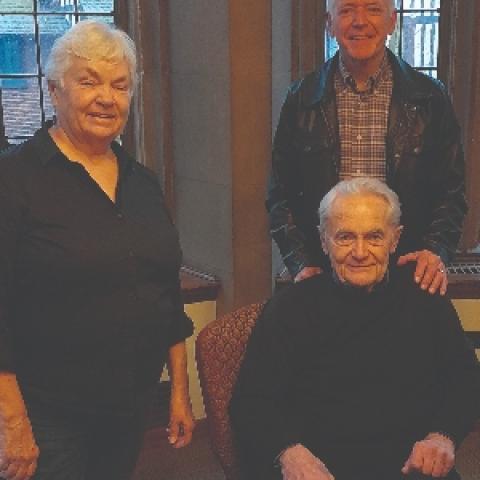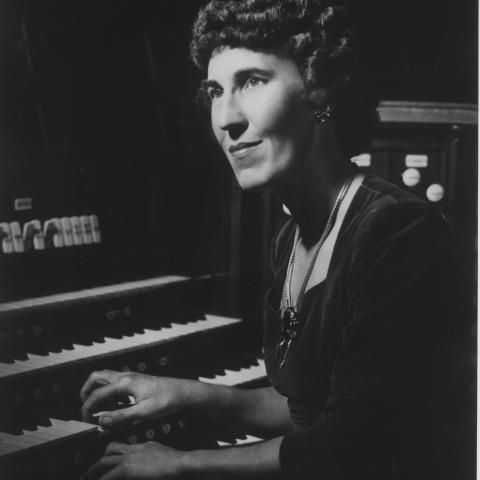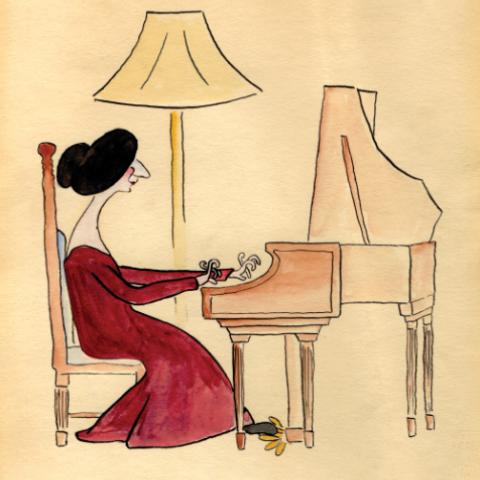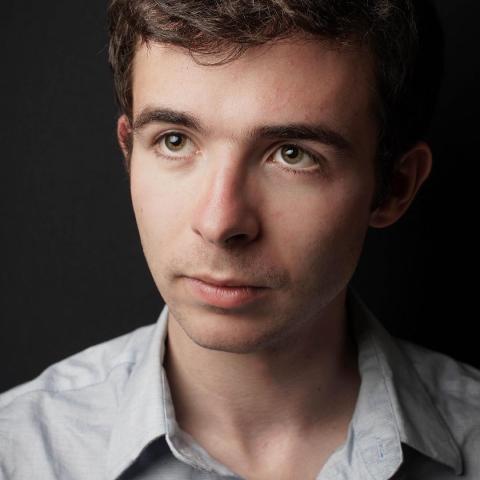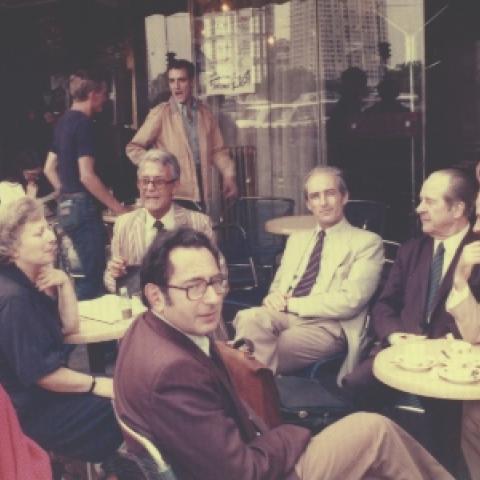
From A to Z: Harpsichord Notes
Seated one day at the computer, I was weary and ill at ease, and my fingers wandered idly over the noisy keys . . . oops, wrong setting. Or is it? I have just been searching a list of past winners of the quarterly Global Music Awards bestowed on independent musicians who submit their recordings for judging by a California company, and I have come across the welcome information that Asako Hirabayashi, harpsichordist and composer, won a first prize medal in the year 2018.
Thus, belatedly, I wish to congratulate Asako for the recognition that has been bestowed on her for the compact disc The Harpsichord in the New Millennium (Albany: Troy 1180) that I have mentioned previously in these columns. Asako, who also won first prizes for her submissions to the Alienor Harpsichord Composition Competitions in 2004 and 2012, is a current member of the Historic Keyboard Society of North America (HKSNA), and she continues her career as a virtuoso player as well as a celebrated composer. Brava, Asako!
A duo and The Harpsichord Diaries
One of the highlights of the HKSNA meeting in Huntsville, Texas, this past May was the elegant presentation by Elaine Funaro and her husband Randall Love, “The Salon of Madame Brillon”—to my ears the most enticing of duos for harpsichord and fortepiano—a four-movement Duo in C Minor by Anne Louise Brillon de Jouy (1744–1824), a composer totally new to me. To introduce her, I quote from a brief program note, “Pupil of Schobert and friend of Boccherini, Mme. Brillon, (according to Charles Burney), one of the greatest lady-players on the harpsichord in Europe, and to this lady many of the famous composers of Italy and Germany, who have resided in France at any time, have dedicated their works.” Her music is a fascinating window into the cosmopolitan culture of pre-revolutionary France. Also of somewhat prurient interest was the declaration by the Love-Duo that the lady had also been a special friend of Ambassador Benjamin Franklin, whom she addressed as “mon cher papa!”
The finesse and delicacy of nuance displayed by Elaine at the harpsichord and Randall at the fortepiano provided some of the best music making of the entire meeting. The Love family is totally engaged in the arts, both aural and visual.
For some years now I have had the pleasure of a preview copy of the forty-four-page book, The Harpsichord Diaries: A Musical Journey, given to me by Elaine at the HKSNA conference in Montreal. Another brilliant event in Huntsville was an impromptu viewing of the video now completed to accompany this book, the purpose of which is similar to that of the recording “Said the Piano to the Harpsichord,” the first exposure to our instrument touted by so many prominent harpsichord aficionados and professionals such as master builder Richard Kingston, who claim that iconic recording as their first exposure to historic keyboards. With Haiku written by Elaine, who with her pianist husband made the compact disc that accompanies the written story, and narration by son Eric Love (a Broadway actor), plus the book’s illustrations by his twin sister Andrea Love, one may say accurately that this is a “family endeavor.”
The book itself is a musical tale about a girl named Elena who discovers a magical book in her grandmother’s attic. Transported through five centuries, Elena meets eccentric talking harpsichords that bring music and history to life. Check it out online at www.harpsichorddiaries.com, and be enchanted anew by a delightful musical and visual journey.
Twentieth-centuryharpsichord concertos
A most satisfying compact disc by the virtuoso harpsichordist Jory Vinikour is the latest offering from this artist for Cedille (CDR 90000 188, www.cedillerecords.org). Ably supported by the Chicago Philharmonic Orchestra conducted by Scott Speck, at long last one can hear Ned Rorem’s Concertino da Camera. Composed in 1946, the work provides seventeen minutes of legendary status, finally receiving its world premiere recording.
I had known of this concerto, but did not expect ever to hear it. With typical Rorem finesse, and the aid of a cornet that serves as excellent melodic foil to the virtuoso keyboard writing, this work, at least from my point of view, is the best reason for purchasing this disc.
The other concerti on this bountiful disc offer the three far too brief movements of Walter Leigh’s (1905–1942) hauntingly beautiful Concertino (three British pastoral beauties by a composer who died far too soon). I have performed this work for harpsichord and strings quite a number of times, and, together with my listeners, always wanted more of this pastoral beauty.
Two more bracing bits of modernism fill out the disc: Concerto for Harpsichord and Strings, opus 42 (just slightly more than twenty-eight minutes comprise its three movements: “Allegro,” “Andante,” and “Allegro vivo”) by Victor Kalabis and the Concerto for Amplified Harpsichord and Strings by Michael Nyman (twenty-one minutes). This is not for the weak of heart, but I suspect it grows on one with repeated listenings.
Jory Vinikour, who with his duo partner Philippe LeRoy performed the stunning duo harpsichord opening concert at the Huntsville HKSNA meeting, sought suggestions from Robert Tifft, friend and colleague at Southern Methodist University, when he began selecting the works for this recording. As I have said many times, Robert is indeed the person to consult. He is not only knowledgeable but extremely generous in sharing this information—another prince among harpsichord aficionados.
One Hundred Miracles: A Memoir of Music and Survival, by Zuzana Ružicková (with Wendy Holden)
This most remarkable book from Bloomsbury Publishing (London, 2019) is the great Czech harpsichordist’s autobiography as told to British author Wendy Holden in recorded interviews, completed shortly before Ružicková’s death in 2017.
It is dedicated to Johann Sebastian Bach, to whom she devoted a significant amount of her career studying and performing. In fact, it was a small copy of one of Bach’s works that helped give her the stamina to survive three Nazi concentration camps during World War II.
With striking prose presented in chapters that are not ordered chronologically, but are arranged as a surprisingly effective back and forth narrative that begins with a 1960 post-war concert tour in Transylvania and continues with chapters about childhood and adolescent memories, these are interspersed with other chapters that detail Zuzana’s survival of her internment in three Nazi death camps, her happy marriage, and her very successful post-war life as a concert harpsichordist and teacher. Each of these units is titled simply with the name of the city, town, or other location in which the events occurred.
This memoir details a long and productive life made most meaningful by music and Zuzana’s prodigious musical abilities that included a fantastic memory for the works she performed. As I read the 327 pages of this amazing memoir, I became more and more awestricken with her incredible ability for survival, her deep love for her husband—the composer Victor Kalabis (who predeceased her in 2006)—and for her devotion to Bach’s sublime artistry as a composer.
The interviews with the Suffolk author Wendy Holden, who had previously written the book Born Survivors about three mothers and their babies who survived the Holocaust, were completed only a few days before Ružicková’s death in 2017. They are effectively utilized to tell the compelling narrative of a most important life: that of a person who realized the necessity for keeping these true events in the memories of succeeding generations to help insure that history does not repeat such horrors.
I was reminded how my driving instructor during high school days in Crestline, Ohio, shared photos that he had taken while serving in the armed forces that helped to liberate one of the German concentration camps. Even as early as 1952 there were those who insisted that the Holocaust never happened, but those of us who had seen these actual onsite photographs knew otherwise. This book should be required reading for each succeeding generation in years to come.
The organization into fourteen chapters struck me, as well, since fourteen is a symbolic Bach number. I wonder if that simply happened, or if it was another demonstration of Ružicková’s veneration for the great composer. (In case this bit of number symbolism is unfamiliar to some readers, fourteen is the sum of the alphabetical placement of the letters B-A-C-H
(2 + 1 + 3 + 8); once one begins to comprehend Bach’s love of numbers and clever hidden riddles, it becomes rather evident that he often incorporates his name in measures that are strategically placed in measure fourteen, or after fourteen notes, etc. And, of course, there is his musical signature: B-flat [the German B], A, C, and the H which is B-natural in German musical notation).
I recommend One Hundred Miracles as a book you will find difficult to put down once you have begun to read it; and I believe it might cancel any doubt about the importance of Ružicková and guarantee her a spot among the other great female players of the twentieth century. I do have one caution about the claim that she was the first to record the entire keyboard literature of her favorite composer. Isolde Ahlgrimm recorded thirty volumes for Philips of the Netherlands quite a few years before the Czech artist, and Ralph Kirkpatrick also made a number of German recordings earlier as well.
I checked these facts with Robert Tifft, who suggested that when a documentary was made about Ružicková the producers made the “first recording” claim so often that it is now considered to be a fact. He also agreed with me that, while she was definitely one of the earliest (and while she may have recorded a few obscure pieces that were not in other artists’ repertoire), she was definitely not the very first. However she belongs, without a doubt, among that revered group that includes the remarkable female players Wanda Landowska and Ahlgrimm—and neither one of them left us a written memoir of such brilliance and intensity!

